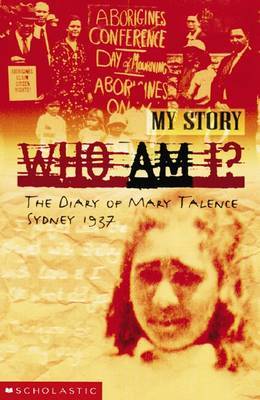An early volume in the Australian adaptation of Scholastic’s very successful ‘My Story’ series, ‘Who Am I? The Diary of Mary Talence, Sydney 1937’ is a novel for younger readers in diary form, by high profile novelist and academic, Dr Anita Heiss, well known as a challenging speaker, anthologist and author of commercial fiction for adults. Her emphasis on engaging an audience, and her talent for it - evident in her 2007 project to write the first Aboriginal ‘chick lit’ for adults - are used to great effect here.
While the epistolary format became too familiar in late 20th century children’s literature - in fictional diaries, exchanges of letters, internet posts, transcribed conversations and so on - here it makes a well researched but potentially dry subject accessible through the fictional first person narration of a child in a specific historical period. In this case the voice is that of a Wiradjuri girl approaching her 11th birthday, and the 150th anniversary of the colonisation of Australia.
Heiss uses her talent as a public speaker to render in print an authentic speaking voice for Mary Talence, giving her a non-standard dialect, which at the time Mary if living would have been marked down for its ‘bad grammar’, ‘incorrect spelling’ and ‘slang’ - ‘we was goin’, ‘kinda’, ‘gammin’. By the time Heiss is writing, however, this is being recognised as a unique variation of Australian English. Its acceptance in print due to the increasing influence of oral delivery and social networking on written usage, which gives the storytelling here a child-friendly appeal.
The question in the title, Who Am I?, is both a cry of distress and a challenge to the society that rips a child from her family - twice - changes her name and insists that she delete from her memory all remnants of her Aboriginal identity. At the age of five, the narrator Amy Charles, renamed Mary Talence, is torn away from not just her parents, but all her brothers and sisters too, and placed in a Home. Heiss’s use of a capital letter is weighted with irony. Although this Home is at Bomaderry on the NSW south coast near the town of Nowra, with its unhappy history of dislocation, Mary is optimistic. She sees the beauty of the natural environment, she cherishes being told by Matron Rose that she is her favourite, because she has lighter coloured skin than the other children. She is Matron’s ‘coffee-coloured princess’. Mary loves the opportunity to sing in church, even though Heiss makes it clear that the church is complicit in the destructive government policies that lurk under the title of the Aboriginal Protection Act.
But the narrator’s optimism and resilience are challenged as she is relocated yet again, this time to Sydney. ‘I already have two families, my real family and the Home, and now I have lost them’ (p.31). Like her name, her religion is changed for her without any consultation and she can’t quite remember the big word starting with ‘A’ that is a powerful influence on her life, though readers will know it is ‘Assimilation’. And when she becomes friendly with an Italian girl, the exclusion of any cultural group defined as Other in Australian society is clear.
In her work with adults, Heiss often divides the audience despite - or maybe because of? - her brilliant intellect, her comic flair and her self-confidence. But the layering of cultural and political nuance here shows her acutely aware of ways to communicate with children. As the plot moves towards Mary’s 11th birthday and the anticipated anniversary of 150 years since colonisation, a girl who loves to laugh and sing and play knows that there are reasons for Australians to celebrate, but what is it that we are celebrating? ‘Who Am I?’ begins as a question asked by one young girl, but it ends as a question for a whole society.
Heiss was born in Sydney and is a member of the Wiradjuri nation of central New South Wales.
Series: My Story

